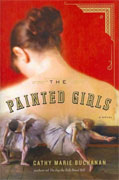The Painted Girls
Cathy Marie Buchanan
book reviews:
· general fiction
· chick lit/romance
· sci-fi/fantasy
· graphic novels
· nonfiction
· audio books
· author interviews
· children's books @
curledupkids.com
· DVD reviews @
curledupdvd.com
newsletter
win books
buy online
links
home
for authors
& publishers
for reviewers

 |
The Painted Girls Cathy Marie Buchanan Riverhead Hardcover 368 pages January 2013 |
|
In The Painted Girls
Opening his tale just as the gloomy morning creeps though the one window of their ramshackle lodging room, Buchanan paints the girls’ daily struggle for survival without a father and with a mother who fingers the bottle of absinthe in the pocket of her skirt. Living on the highest floor of a rue de Douai lodging house with a spiral staircase too narrow to climb, Marie, Antoinette, and younger sister Catherine, inhabit the lower slopes on Montmartre, a veritable stew of the unwashed bourgeois and of poor laborers, craftsmen, artists and models. While Antoinette hopes that one day she might appear on the stage as a principle dancer, she and Marie set their sights on the dance school, hoping for a place in the corps de ballet which the wealthy, influential men of Paris ogle every night from the orchestra stalls. Antoinette proves to be the more headstrong sister. From the get-go, she seems to know exactly what she wants and forges forward full steam ahead. There is no denying her drunken love after she has her first sweaty sexual encounter with handsome, gruff Emile Abadie in the practice rooms tucked up under the rafters of the Opera roof. We may or may not cheer for Antoinette’s choice in securing Emile as the coveted feather in her cap, but his subsequent charge for murder makes us confused over Antoinette’s disheartened and misguided loyalty. Marie is called by ballet master Madame Dominique to the rehearsal floor, where Monsieur Degas is visiting the girls. An illusory, ghost-like force, Degas wants Marie to model. As his burning eyes rove over her rare goose-flesh skin, she becomes “but a fearful girl sucking on her lip.” Wise and compassionate, Marie remains burdened by her painful existence even as she leaps and turns, cramming every bit of learning into her bones. While Madame works with Marie until her legs are close to collapsing, her head filling with the “rampaging shriek of a maestro, and the foul mouth of an etoile,” Marie attends Degas' private studio where master and muse become one and the seeds are sown of what will ultimately become the brokenhearted girl and her blazing red shawl. Buchanan makes the underbelly of Paris come alive and makes Marie and Antoinette compassionate characters; we genuinely want them to rise above their poverty and find success and happiness. The author links Emile Zola’s naturalist observations to her own scientific search for truth in sisterhood. From the “petits rats”--the scrawny, hopeful girls vying for “the lightest leap; the prettiest arms”--to the love affair between Antoinette and Emile, from a boy forced into petty thievery to survive to the many scenes where Marie and Antoinette shiver by candlelight, worrying where their next meal will come from, we see the sisters becoming more and more degraded until the almost unspeakably horrible conclusion. Buchanan amasses a palette full of sensory experience and observational detail, culminating in the harrowing humiliations suffered by Antoinette at novel's end. This is made worse by the notion that her troubles do not come from "the rich" but from her fellow poor, who delight in pounding her into the dirt. Antoinette and Marie’s life is a monument to naturalist realism (and to Degas’ timeless art) as Buchanan shows us the slums of Paris where only those with great strength of character and mind can survive the endless squalor and degradation. Originally published on Curled Up With A Good Book at www.curledup.com. © Michael Leonard, 2013 |
|
|
|
 Click here to learn more about this month's sponsor! |
|
| fiction · sf/f · comic books · nonfiction · audio newsletter · free book contest · buy books online review index · links · · authors & publishers reviewers |
|
| site by ELBO Computing Resources, Inc. | |
 As the girls’ life of poverty
and prostitution unfolds, Buchanan gives voice to the sisters. The candid realism of their lives in the nineteenth century hits us like a ton of bricks, from the unwashed masses as they look and live in the sweatiest, smelliest, grimiest parts of the city, to the bars
and the slums and the brothels and the destitute workhouses. While alcoholism and poverty are undeniably the novel’s themes, they’re presented not so much as a symptom of personal irresponsibility but rather a product of the era’s economic, political and religious issues.
As the girls’ life of poverty
and prostitution unfolds, Buchanan gives voice to the sisters. The candid realism of their lives in the nineteenth century hits us like a ton of bricks, from the unwashed masses as they look and live in the sweatiest, smelliest, grimiest parts of the city, to the bars
and the slums and the brothels and the destitute workhouses. While alcoholism and poverty are undeniably the novel’s themes, they’re presented not so much as a symptom of personal irresponsibility but rather a product of the era’s economic, political and religious issues.